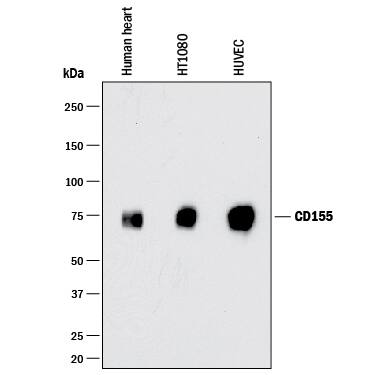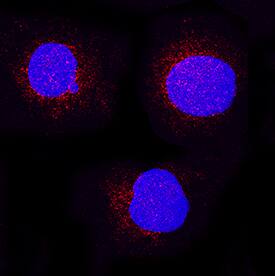Human CD155/PVR Biotinylated Antibody
R&D Systems, part of Bio-Techne | Catalog # BAF2530


Key Product Details
Species Reactivity
Applications
Label
Antibody Source
Product Specifications
Immunogen
Gly27-Asn343
Accession # AAH15542
Specificity
Clonality
Host
Isotype
Scientific Data Images for Human CD155/PVR Biotinylated Antibody
Detection of Human CD155/PVR by Western Blot.
Western blot shows lysates of human heart tissue, HT1080 human fibrosarcoma cell line, and HUVEC human umbilical vein endothelial cells. PVDF membrane was probed with 0.5 µg/mL of Goat Anti-Human CD155/PVR Biotinylated Antigen Affinity-purified Polyclonal Antibody (Catalog # BAF2530) followed by Streptavidin-HRP (Catalog # DY998). A specific band was detected for CD155/PVR at approximately 75 kDa (as indicated). This experiment was conducted under reducing conditions and using Immunoblot Buffer Group 1.CD155/PVR in U937 Human Cell Line.
CD155/PVR was detected in immersion fixed U937 human histiocytic lymphoma cell line using Goat Anti-Human CD155/PVR Biotinylated Antigen Affinity-purified Polyclonal Antibody (Catalog # BAF2530) at 15 µg/mL for 3 hours at room temperature. Cells were stained using the NorthernLights™ 557-conjugated Anti-Goat IgG Secondary Antibody (red; Catalog # NL001) and counterstained with DAPI (blue). Specific staining was localized to cytoplasm. View our protocol for Fluorescent ICC Staining of Non-adherent Cells.Applications for Human CD155/PVR Biotinylated Antibody
Immunocytochemistry
Sample: Immersion fixed human peripheral blood mononuclear cells and U937 human histiocytic lymphoma cell line
Western Blot
Sample: Human heart tissue, HT1080 human fibrosarcoma cell line, and HUVEC human umbilical vein endothelial cells
Formulation, Preparation, and Storage
Purification
Reconstitution
Formulation
Shipping
Stability & Storage
- 12 months from date of receipt, -20 to -70 °C as supplied.
- 1 month, 2 to 8 °C under sterile conditions after reconstitution.
- 6 months, -20 to -70 °C under sterile conditions after reconstitution.
Background: CD155/PVR
CD155 [also known as PVR (poliovirus receptor) and Necl-5 (nectin-like molecule-5)] is a 70 kDa type I transmembrane (TM) glycoprotein that is a member of the nectin-like (Necl) family of nectin-related molecules (1). Like nectins, Necl molecules are Ig superfamily members that contain three Ig-like extracellular domains, a TM segment, and a cytoplasmic tail. Unlike nectins, Necl molecules cannot interact with cytoplasmic afadin (1). While Nectins serve as cell adhesion molecules, the actual functions of most Necls are yet-to-be determined. CD155/PVR was originally isolated based on its ability to mediate polio virus attachment to host cells (2, 3). The full-length (or CD155 alpha isoform) is synthesized as a 417 amino acid (aa) precursor that contains a 20 aa signal sequence, a 323 aa extracellular region, a 24 aa TM segment and a 50 aa cytoplasmic tail. The extracellular region contains one N-terminal V-type and two C2-type Ig-like domains (2, 3). The V‑type domain mediates polio virus binding (4). Three other isoforms exist, all of which retain the Ig-like domains. CD155 delta is transmembrane with a shortened cytoplasmic tail of 25 aa. CD155 beta (352 aa) and CD155 gamma (344 aa) are 60‑65 kDa soluble forms that show removal of the TM segment and surrounding amino acids (2, 5). The soluble forms will bind the polio virus (due to the presence of the V-type Ig domain) but afford no protection against polio infection because of low circulating levels (5). CD155 has been demonstrated to bind vitronectin, nectin-3, and DNAM-1 (6‑8). DNAM-1 binding promotes monocyte migration and NK cell killing. CD155 is expressed in all normal tissues and is highly expressed in tumor cells of epithelial and neuronal origin.
References
- Takai, Y. et al. (2003) Cancer Sci. 94:655.
- Mendelsohn, C.L. et al. (1989) Cell 56:855.
- Koike, H. et al. (1990) EMBO J. 9:3217.
- Koike, S. et al. (1991) Proc. Natl. Acad. Sci. USA 88:4104.
- Baury, B. et al. (2003) Biochem. Biophys. Res. Commun. 309:175.
- Mueller, S. and E. Wimmer (2003) J. Biol. Chem. 278:31251.
- Reymond, N. et al. (2004) J. Exp. Med. 199:1331.
- Lange, R. et al. (2001) Virology 285:218.
Long Name
Alternate Names
Entrez Gene IDs
Gene Symbol
UniProt
Additional CD155/PVR Products
Product Documents for Human CD155/PVR Biotinylated Antibody
Product Specific Notices for Human CD155/PVR Biotinylated Antibody
For research use only
